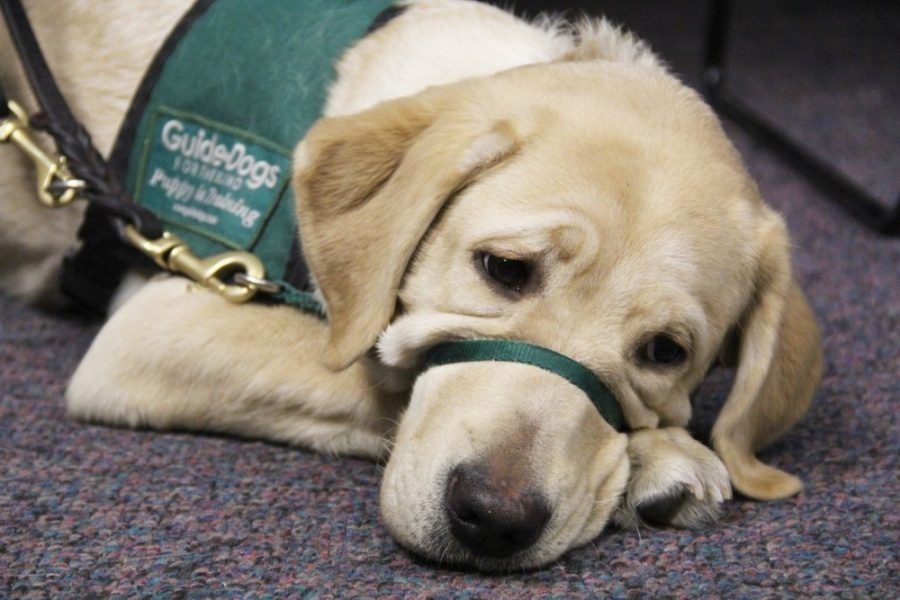A “helicopter parent,” essentially a hovering, overprotective parent, may not be the best candidate to raise a future guide dog, according to new research from the Arizona Canine Cognition Center.
A new study indicated that the most successful guide dogs had less attentive mothers as puppies.
The study, headed by Emily Bray, a post-doctoral researcher at the Arizona Canine Cognition Center and the School of Anthropology, was done at The Seeing Eye. The Seeing Eye is a New Jersey-based nonprofit organization devoted to breeding, raising and training service dogs for the blind.
Motivated by a love of dogs, Bray wanted to explore cognitive development in puppies who would go on to become guide dogs.
“I was interested in looking at early development to see the sort of things that ultimately make a good guide dog,” Bray said.
She started with early interactions between the puppies and their mothers.
“We know that, across rodents and primates, those sorts of interactions over the first few weeks of life are really crucial in terms of later outcomes for the offspring,” Bray said.
RELATED: Dogs and toddlers possess similar emotional intelligence
After observing early interactions, Bray then observed different characteristics that emerged between the puppies at a slightly older age.
To do so, Bray visited The Seeing Eye during its breeding season and set up a surveillance system to watch the puppies and their mothers. She monitored specific aspects of these interactions such as the amount of time mothers spent with their litters and how often mothers nursed and groomed them. These observations were then used as data.
When the puppies reported for training, Bray followed them and tested them on behavioral tasks.
“Essentially, we played games with them to try to get a window into their temperament and problem-solving skills,” Bray said.
For example, during the second stage of the research, Bray said she tested the puppies on problem-solving skills and their ability to deal with stress by placing them in a room with a moving, vocalizing cat and testing how long it took them to vocalize.
“We see this as a measure of anxiety,” said Bray. “So the quicker the dog was to vocalize … that signifies a more anxious dog.”
Dogs that were quicker to growl or whine during a moment of stress were less likely to be accepted into the guide dog training program, according to Bray.
The two parts of the project allowed for a unique approach to observing canine behavior and the influence of the mother on the puppy.
 While there was a definite connection between maternal style and how the puppies developed and performed in the behavioral tests, the results were unexpected, Bray said.
While there was a definite connection between maternal style and how the puppies developed and performed in the behavioral tests, the results were unexpected, Bray said.
“We found that the mothers who were most involved …these overly attentive mothers ended up having puppies who were more likely to be released from the programs,” said Bray. “Similarly, if you look at their behavior, these were the dogs that were more anxious and not as good at independent problem solving.”
Hands-off mothers produced more successful puppies, Bray said.
This effect is also seen in squirrel monkeys. When mothers leave their babies behind for short periods of time, they become more resistant to stress. This can allow for better problem-solving skills and independent thinking.
Several theories are being considered to explain the effect of overbearing mothers, Bray said. One is that the puppies are prevented from learning how to overcome small challenges on their own and are therefore more prone to stress. Another theory focuses on how the most attentive mothers also demonstrated the highest levels of cortisol — a hormone responsible for stress — and might be passing it down to the puppies.
RELATED: Canine cognition center explores dog smarts
The field is very new, meaning more research is needed to determine the cause of the puppies’ performance. Bray said she hopes to do more of her own research into the topic, particularly with the Arizona Canine Cognition Center.
Bray’s research also helped demonstrate which of the many traits are necessary for a successful guide dog.
Candidates for guide dog training must possess several important traits, Bray said.
“Many of the reasons guide dogs fail are behavioral,” said Bray. “It’s really important that these dogs have a certain temperament and certain problem-solving abilities.”
Besides the more obvious traits, such as a lack of aggression and noise tolerance, successful guide dogs have to be able to stay on task, ignoring squirrels and people who want to play with them, Bray said. They also have to strike a balance between confidence and a calm demeanor. All of these requirements mean that the right upbringing and training of the puppies, particularly from their mothers, is absolutely crucial.
Follow Nicole Morin on Twitter









